Cannibals at Walt Disney World!
Image: Disney
Why didn’t Beastly Kingdom become a part of phase two of Animal Kingdom? Let’s now have an odd discussion about park attendance and its shocking impact on the fate of Beastly Kingdom, starting with a simple question. Why did Disney build Animal Kingdom? The answer isn’t altruism. Yes, Walt Disney himself was a champion of environmental causes and animal conservation. Yes, even the early days of Disney television series featured interactions with nature, a premise they’ve honored with their recent line of Disneynature movie releases. But the corporation’s love of planet Earth and all of its inhabitants only goes so far. It’s money that matters.
The core concept to Animal Kingdom was that it would secure the short-term future of Walt Disney World after the hiccup at Disney-MGM Studios. Everyone involved from Eisner down to the Imagineers to loyal cast members believed that a fifth park was only a matter of time. Still, Animal Kingdom stood above the other 1990s structures as the most important project. Its overriding purpose was to boost attendance at Walt Disney World.
Even the harshest skeptics of this project never questioned its appeal. Analysts and fans alike universally acknowledged that their fears about Animal Kingdom involved functionality, not drawing power. Building and sustaining innumerable ecosystems in plain sight of the viewing public seemed like a daunting if not impossible situation for Disney. Everyone agreed that if they pulled it off, they’d reap the financial rewards.
Oops.
Image: Disney
A concept called cannibalism exists in the theme park world. Don’t worry. It’s not quite as Donner Party as it sounds. Disney execs describe one of their worst traffic problems by using this particular term. To them, cannibalism occurs when the creation of some new attraction or exhibition pulls attendance away from other, similar venues.
As an example, when Disney builds a new restaurant, they don’t want to siphon attendance away from existing restaurants. Instead, their goal is to expand the overall appeal at eating at a Disney theme park rather than bringing your own food or leaving the park to eat somewhere else. Disney is now paying additional costs for constructing and staffing a new business onsite. They need to counterbalance those expenses by earning more revenue thanks to customer patronage.
The concept of cannibalism drives a surprising number of decisions at the various Disney theme parks. Shows and fireworks in particular are worrisome since these activities require a lot of a guest’s free time. Disney has to structure the displays in a way that attendants will remember to keep their wallets open. Otherwise, by offering such wonderful distractions, Disney decreases its own bottom line each day.
Never celebrate until you’re in the end zone
Image: Disney
The ultimate cautionary tale of cannibalism at Walt Disney World is, perhaps fittingly, Animal Kingdom. After spending almost a billion dollars to build and staff their fourth gate, Disney execs were euphoric about its early reviews. Virtually all of them championed the park as a hallmark achievement in theme park design and execution. Of particular note to critics was that Disney somehow introduced thousands of animals to the natural habitat of central Orlando without endangering them or the strangers suddenly interacting with them on a daily basis. And a lot of folks, myself included, were shocked that Animal Kingdom didn’t have that zoo/country fair smell. In short, Animal Kingdom’s debut was best case scenario for Disney, a much needed win after a few years of theme park disappointments.
Before Eisner could take his victory lap, the attendance numbers started to pour in. They were…surprising. Yes, attendance was solid at Animal Kingdom. In its first year, which was really just the last eight months of 1998, six million guests attended. That was a larger total than Universal Studios Hollywood managed for the entire year, and it crushed a couple of other popular local theme parks, SeaWorld Orlando and Busch Gardens Tampa Bay, too. That was the good news.
The bad news for Disney and Eisner was that attendance at all three other gates at Walt Disney World dropped in 1998. And then they dropped again in 1999. It’s true. In 1997, Magic Kingdom counted 17 million visits from guests. The following year, that total dropped a hefty eight percent to 15.6 million and then fell another three percent to 15.2 million in 1999. Epcot started with 11.9 million in 1997 but finished 1999 with only 10.1 million. Disney-MGM Studios also fell from 10.5 million to 8.7 million.
Image: Disney
Take a moment to think about these statistics from the Disney perspective. They had just invested a billion dollars to earn a traffic spike from loyal theme park tourists. Instead, something wildly unexpected had happened. Animal Kingdom had cannibalized the other three gates in a historically unprecedented manner.
Yes, the fourth gate garnered 14.6 million in attendance in 1998 and 1999. At the same time, the other three gates lost 9.1 million worth of tourists over a two-year period, with the losses being measured against 1997 park traffic. In other words, MGM fell by a million in 1998 from 1997, and its 1999 total was down an almost incomprehensible 1.8 million from 1997 totals. Disney’s “net gain” was 5.5 million park visits over two years, legitimately a fraction of what they’d projected. The worst news of all for Disney is that every lost customer meant lost revenue in the form of meals, merchandise, snacks, hotel stays, and incidentals.
What’s the consequence of this revenue shortfall? For a multinational conglomerate like Disney, the areas of impact are myriad. The Parks and Resorts division understandably felt it the most since their portion of the ledger was the one with the most troubling numbers. Walt Disney not only failed to capitalize on the addition of a fourth gate but found itself struggling to pay for the venture due to shaky attendance figures across the entire Walt Disney World campus.
Beastly Kingdoomed
Image: Disney
You don’t have to have a degree in Economics to see where this is going.
The underlying strategy of Disney's Animal Kingdom was to entice theme park tourists to expand their travel plans. Guests would now need to stay an extra day at Walt Disney World to see and do everything. Disney's Animal Kingdom was for all intents and purposes a strategy Disney execs employed to increase their vacation from four days to five or from six days to seven. This may not seem like a huge deal to you, but it’s as much as a 25 percent increase in revenue for a theme park owner. Disney was COUNTING on that income, first to pay for the cost of construction and then later to become a source of evergreen revenue. The traffic shortfall was a setback with far-reaching consequences felt for years in Orlando.
With Animal Kingdom having failed in its primary task, improving Disney’s bottom line in the Parks and Resorts division, reality hit home for most of its champions. Even the most ardent supporters of the concept appreciated that the CEO and board of directors wouldn’t look at Animal Kingdom as worthy of further expenditures, at least not in the short term. Any hope of a massive phase two expansion at the park fell by the wayside.
Twin postscripts
Image: Disney
As Animal Kingdom approached its target opening date, Earth Day of 1998, one more bit of bad news hit Eisner’s desk. Park planners had serious concerns about the volume of park attendees relative to the number of attractions and areas available. They felt the pinch of not having the three spectacular attractions from Beastly Kingdom as well as the expected walking area of that themed land.
After a brainstorming session, Disney’s upper management hastily threw together a permanent summer camp known as Camp Minnie-Mickey. It originally featured a pair of live shows, only one of which has stood the test of time. The failed endeavor was Pocahontas and Her Forest Friends. It lasted a decade but claimed sparse attendance in its final years. The more popular stage show remains today; it’s Festival of the Lion King, the best thing to come out of the failed attempt at building Beastly Kingdom. Other than it, Camp Minnie-Mickey was largely a glorified time killer with some character meeting spots. Disney mercifully shut it down in 2014. And the reason for that is the second postscript.
In 2011, Disney shocked theme park observers, movie analysts, and basically everyone in the business world when they announced a new expansion for Animal Kingdom. Whether you want to call it Phase Two or something else, Pandora – The World of Avatar debuted in 2017. It exists in the same space that Eisner and a team of optimistic, creative Imagineers had once slotted for Beastly Kingdom.
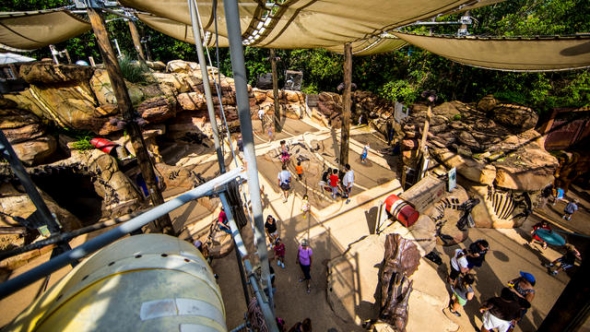
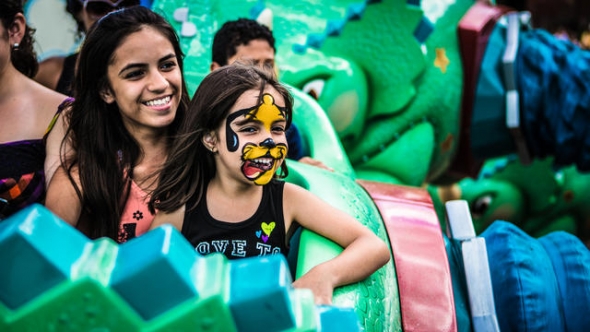
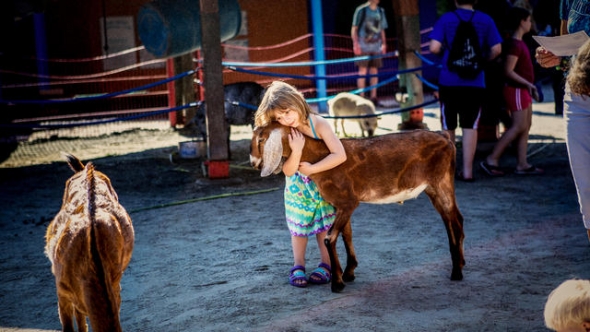
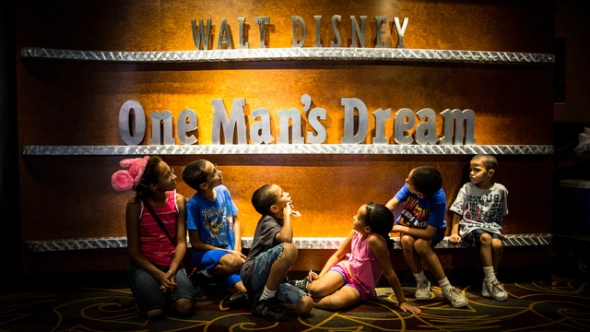
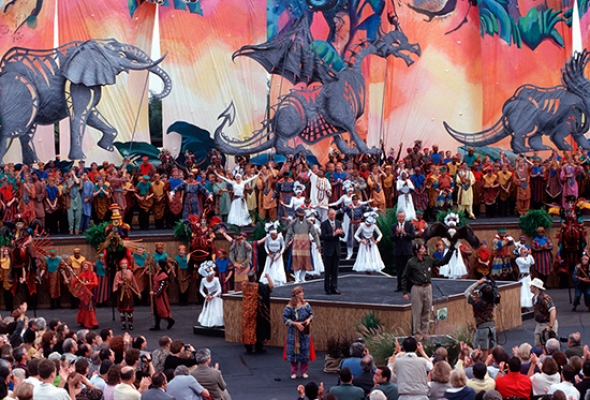
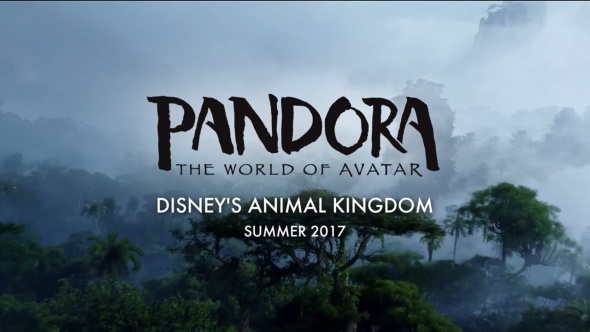

Comments
Eisner, that bastard. Why, why did he have to nix Beastly Kingdom?!!!
Wow, another amazing read. This article really had a lot of good info and really ties in a lot of information as to why this didn't get built. I also was unaware of the attendance declines in the late 90's which really explains why I'm so disappointed when I always compare crowd levels now with back then. This really sheds a lot of light into decisions are made at Disney. I had always thought about the canabilism issue but never knew it could have as dramatic an impact as it apparently did whenever Animal Kingdom was opened.